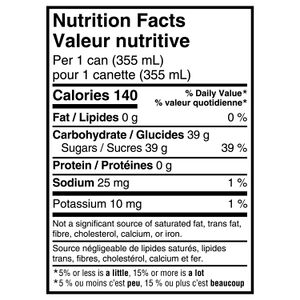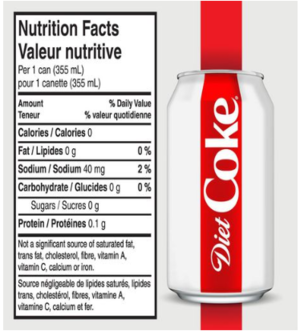Course:FNH200/Assignments/2021/Coca-Cola Coke Coca-Cola vs Diet Coke



Introduction
The brand Coca-Cola was established in 1892 in Atlanta, Georgia, United states. And ever since, Coca-cola has been creating different formula's for different carbonated products. We specifically looked at Coca-Cola and Diet Coke to see the differences between the two and what ingredients were used. With the concept of carbonated drinks such as sodas being labeled "unhealthy", we wanted to see what alternatives were used in diet coke to make it healthier.
Ingredient Lists
| Coca-Cola | Diet Coke |
|---|---|
| Carbonated Water | Carbonated water |
| High fructose corn syrup | Caramel colouring |
| Caramel coloring | Phosphoric acid |
| Phosphoric acid | Citric acid |
| Natural flavours | Aspartame |
| Caffeine | Natural flavours |
| Sodium benzoate | |
| Acesulfame-potassium | |
| Caffeine |
Identifying Fat Substitutes, Sugar Substitutes and Additives
| Fat Substitutes | Sugar Substitutes | Additives | |
|---|---|---|---|
| Coca-Cola | None | None | Caramel colouring |
| Diet Coke | None | Aspartame
Acesulfame potassium |
Citric acid
Sodium benzoate |
Roles of Fat Substitutes, Sugar Substitutes and Additives
| Substitutes/Additives | Role |
|---|---|
| Aspartame | In Diet Coke, aspartame is used as a sugar substitute to lower caloric intake. By using aspartame,an alternative option is made for consumers [1]. Diet Coke is also stated by Coca-Cola to have no sugar and no calories which is the base of their statement of saying Diet Coke is the healthier alternative. |
| Acesulfame potassium | Another sugar substitute used in diet coke is acesulfame potassium. It is a zero-calorie sugar alternative and it is commonly used in soft drinks, yogurts and candy [2]. |
| Caramel colouring | Caramel colouring is used to give Coca-Cola its signature dark colouring [3]. |
| Citric acid | Citric acid provides a sharp, sour taste to Diet Coke, and also reacts with baking soda to release carbon dioxide from the baking soda, creating the bubbles in Coca Cola [4] |
| Sodium benzoate | Sodium Benzoate is a preservative that extends shelf life [5]. It also protects the taste of Coca-Cola [5]. |
Compare and Contrast
| Base Ingredients (Same) | Others (Different) |
|---|---|
| Carbonated water | Aspartame |
| Caramel colouring | Acesulfame-potassium |
| Phosphoric acid | Citric acid |
| Caffeine | Sodium benzoate |
| Natural flavours |
Base Ingredients
Coca-Cola and diet coke share some of the same base ingredients. Carbonated water, caramel colouring, phosphoric acid, caffeine and natural flavours are all examples of base ingredients that are included in both Coca-Cola and Diet Coke.
Sweeteners
Aspartame is used in small quantities as a sugar alternative for their Diet Coke brand to be healthier with 0 calories and 0 sugar. Although aspartame is said to yield 4 Cal/g, the quantity used in the drinks make it very close, if not 0 calories because aspartame is 180-220 times sweeter than regular sugar [1]. In comparison with Coca-Cola, high fructose corn syrup is used as the main sweetener as it is not worried about the calories that it adds into the drink.
Acesulfame-potassium is another sugar alternative used in diet coke that is calorie-free [2].
Additives
Citric acid enhances the flavoring in diet Coca-Cola, by giving it the sour, tart taste [4].
Sodium benzoate is added into Diet Coke to extend its shelf life by not allowing the microorganisms that are responsible for food degradation to reproduce during storage [5][6]. There should be caution when consuming drinks that contain sodium benzoate because of it's ability to combine with ascorbic acid and convert into benzene [7]. Benzene is classified as a carcinogen which can cause cancer, more specifically leukemia and other blood-forming cancers [7].
Labels
| Coca-Cola | Diet Coke | |
|---|---|---|
| Bilingual labelling | Yes (English and French) | Yes (English and French |
| Common name of the food | Coca-Cola | Diet Coke |
| Country of Origin | United States | United States |
| Date marking and storage instructions | "Best before date" on can/bottle; no storage instructions | "Best before date" on can/bottle; no storage instructions |
| Identity and principal place of business | Atlanta, Georgia | Atlanta, Georgia |
| Irradiated foods | Not irradiated so there is no label needed | Not irradiated so there is no label needed |
| Legibility and location | Label is printed onto either a label (bottle) or directly onto
the can and is easily legible/readable |
Label is printed onto either a label (bottle) or directly onto
the can and is easily legible/readable |
| List of ingredients | Located to the side of nutrition facts table | Located to the side of nutrition facts table |
| Nutrition facts table | Includes all the necessary information in nutrition facts table
(e.g. serving size, calories, total fat, sodium, etc.) |
Includes all the necessary information in nutrition facts table
(e.g. serving size, calories, total fat, sodium, etc.) |
| Net quantity of the food | 355 mL (1 can) | 355 mL (1 can) |
| Sweeteners | Indicated on ingredients list (e.g. high fructose corn syrup) | Indicated on ingredients list (e.g. aspartame, acesulfame-potassium) |
| Nutrient content claims and diet-related health claims | "Not a signficant source of saturated fat, trans fat, fibre, cholesterol, calcium or iron" | "Not a signficant source of saturated fat, trans fat, cholesterol, fibre, vitamin A, vitamin C, calcium or iron" |
References
- ↑ 1.0 1.1 Chan, Judy. (2021, August). 3.1 Fat and Sugar Substitutes. Lecture.
- ↑ 2.0 2.1 Chappell, Grace; Wikoff, Daniele; Coepker, Candace; Borghoff, Susan (July 2020). "Lack of potential carcinogenicity for acesulfame potassium – Systematic evaluation and integration of mechanistic data into the totality of the evidence". Food and Chemical Toxicology. 141 – via ScienceDirect.
- ↑ "Are there any additives in Coca‑Cola?". Coca Cola Great Britain. October 1, 2020.
- ↑ 4.0 4.1 "Why is citric acid added to soft drinks?". Socratic. March 4, 2017.
- ↑ 5.0 5.1 5.2 Brennan, Dan (April 12, 2021). "What is Sodium Benzoate? Is it safe for use as a Food preservative?". WebMD.
- ↑ Ren, Linlin; Meng, Meng; Wang, Peng; Zhihuan, Xu; Segei, Eremin; Junhong, Zhao; Yongmei, Yin; Rimo, Xi (April 2014). "Determination of sodium benzoate in food products by fluorescence polarization immunoassay". Talanta. 121: 136–143 – via ScienceDirect.
- ↑ 7.0 7.1 Azuma, S; Quartey, N; Ofosu, Isaac (November 2020). "Sodium benzoate in non-alcoholic carbonated (soft) drinks: Exposure and health risks". Scientific African. 10 – via ScienceDirect.
| This Food Science resource was created by Course:FNH200. |
